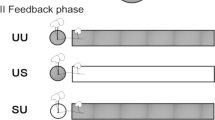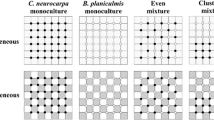Abstract
Background
Resource translocation among interconnected ramets can improve the growth performance of the recipient ramets and influence soil properties and microbial communities in the rooting zone. However, scanty attention has been paid to the effect of this clonal integration on soil biotic and abiotic characteristics of neighboring species around the recipient ramets.
Methods
We conducted a soil heterogeneous experiment in which the mother ramet of the ramet pair for Vallisneria natans was planted in a high-nutrient patch, and the daughter ramet was planted in a low-nutrient patch with conspecific neighbors V. natans or heterospecific neighbors Myriophyllum spicatum. The stolons between ramet pairs were severed or left intact.
Results
Our results showed that effects of clonal integration on growth of the daughter ramet depend on the identity of neighboring species. Overall growth of neighbors V. natans was not affected by clonal integration, while growth of neighbors M. spicatum was greatly reduced. Soil properties and microbial community composition (especially bacteria) in the rhizosphere of neighboring plants were significantly influenced by clonal integration, and these effects were more obvious in the rhizosphere of neighbor V. natans than those in the rhizosphere of neighbors M. spicatum.
Conclusion
Our study suggests that clonal integration may play a vital role in facilitating nutrient cycling, modifying habitat heterogeneity and affecting interspecific interactions and even the community structure.
Graphical abstract









Similar content being viewed by others
Data availability
The datasets generated during and/or analysed during the current study are available from the corresponding author on reasonable request.
References
Bonanno G, Vymazal J, Cirelli GL (2018) Translocation, accumulation and bioindication of trace elements in wetland plants. Sci Total Environ 631:252–261
Březina S, Koubek T, Münzbergová Z, Herben T (2006) Ecological benefits of integration of Calamagrostis epigejos ramets under field conditions. Flora 201:461–467. https://doi.org/10.1016/j.flora.2005.10.003
Butler JL, Bottomley PJ, Griffith SM, Myrold DD (2004) Distribution and turnover of recently fixed photosynthate in ryegrass rhizospheres. Soil Biol Biochem 36:371–382
Chen JS, Li J, Zhang Y, Zong H, Lei NF (2015) Clonal integration ameliorates the carbon accumulation capacity of a stoloniferous herb, Glechoma longituba, growing in heterogenous light conditions by facilitating nitrogen assimilation in the rhizosphere. Ann Bot 115:127–136. https://doi.org/10.1093/aob/mcu207
Dai L, Zhang G, Yu Z, Ding H, Xu Y, Zhang Z (2019) Effect of drought stress and developmental stages on microbial community structure and diversity in peanut rhizosphere soil. Int J Mol Sci 20:2265. https://doi.org/10.3390/ijms20092265
Dang K, Gong X, Zhao G, Wang H, Ivanistau A, Feng B (2020) Intercropping alters the soil microbial diversity and community to facilitate nitrogen assimilation: a potential mechanism for increasing Proso millet grain yield. Front Microbiol 11:601054. https://doi.org/10.3389/fmicb.2020.601054
de Menezes AB, Prendergast-Miller MT, Poonpatana P, Farrell M, Bissett A, Macdonald LM, Toscas P, Richardson AE, Thrall PH (2015) C/N ratio drives soil actinobacterial cellobiohydrolase gene diversity. Appl Environ Microbiol 81:3016–3028. https://doi.org/10.1128/aem.00067-15
Duchoslavová J, Jansa J (2018) The direction of carbon and nitrogen fluxes between ramets changes during ontogeny under simulated competition for light. J Exp Bot 69:2149–2158. https://doi.org/10.1093/jxb/ery068
Ekenler M, Tabatabai MA (2002) β-Glucosaminidase activity of soils: effect of cropping systems and its relationship to nitrogen mineralization. Biol Fertil Soils 36:367–376
Ekenler M, Tabatabai M (2004) β-Glucosaminidase activity as an index of nitrogen mineralization in soils. Commun Soil Sci Plant Anal 35:1081–1094
Evans JP (1992) The effect of local resource availability and clonal integration on ramet functional morphology in Hydrocotyle bonariensis. Oecologia 89:265–276. https://doi.org/10.1007/bf00317227
Gou M, Qu YY, Yang H, Zhou JT, Li A, Guan XY, Ai FF (2008) Sphingomonas sp.: a novel microbial resource for biodegradation of aromatic compounds. Chin J App Environ Biol 14:276–282
Hartnett DC, Bazzaz FA (1985) The integration of neighbourhood effects by clonal genets in Solidago canadensis. J Ecol 73:415–427
He WM, Alpert P, Yu FH, Zhang LL, Dong M (2011) Reciprocal and coincident patchiness of multiple resources differentially affect benefits of clonal integration in two perennial plants. J Ecol 99:1202–1210
Herben T (2004) Physiological integration affects growth form and competitive ability in clonal plants. Evol Ecol 18:493–520
Hong C, Si Y, Xing Y, Li Y (2015) Illumina MiSeq sequencing investigation on the contrasting soil bacterial community structures in different iron mining areas. Environ Sci Pollut Res 22:10788–10799. https://doi.org/10.1007/s11356-015-4186-3
Hutchings MJ, Wijesinghe DK (1997) Patchy habitats, division of labour and growth dividends in clonal plants. Trends Ecol Evol 12:390–394
Ivančič I, Degobbis D (1984) An optimal manual procedure for ammonia analysis in natural waters by the indophenol blue method. Water Res 18:1143–1147
Janeček S, Kantorová J, Bartoš M, Klimešová J (2008) Integration in the clonal plant Eriophorum angustifolium: an experiment with a three-member-clonal system in a patchy environment. Evol Ecol 22:325–336. https://doi.org/10.1007/s10682-007-9203-7
Kandeler E, Gerber H (1988) Short-term assay of soil urease activity using colorimetric determination of ammonium. Biol Fertil Soils 6:68–72
Koranda M, Schnecker J, Kaiser C, Fuchslueger L, Kitzler B, Stange CF, Sessitsch A, Zechmeister-Boltenstern S, Richter A (2011) Microbial processes and community composition in the rhizosphere of European beech - the influence of plant C exudates. Soil Biol Biochem 43:551–558. https://doi.org/10.1016/j.soilbio.2010.11.022
Li XX, Fan ZW, Shen YD, Li SL, Liu Y, Huang QQ (2017) Effects of clonal integration on the growth of Mikania micrantha in habitats with heterogeneous nutrient availability. Chin J Ecol 36:1271–1276
Li Y, Chen JS, Xue G, Peng Y, Song HX (2018) Effect of clonal integration on nitrogen cycling in rhizosphere of rhizomatous clonal plant, Phyllostachys bissetii, under heterogeneous light. Sci Total Environ 628:594–602. https://doi.org/10.1016/j.scitotenv.2018.02.002
Lin HF, Alpert P, Zhang Q, Yu FH (2018) Facilitation of amphibious habit by physiological integration in the clonal, perennial, climbing herb Ipomoea aquatica. Sci Total Environ 618:262–268. https://doi.org/10.1016/j.scitotenv.2017.11.025
Mack RN, Harper JL (1977) Interference in dune annuals: spatial pattern and neighbourhood effects. J Ecol:345–363
Pang JY, Wang YM, Lambers H, Tibbett M, Siddique KHM, Ryan MH (2013) Commensalism in an agroecosystem: hydraulic redistribution by deep-rooted legumes improves survival of a droughted shallow-rooted legume companion. Physiol Plant 149:79–90. https://doi.org/10.1111/ppl.12020
Pennings SC, Callaway RM (2000) The advantages of clonal integration under different ecological conditions: a community-wide test. Ecology 81:709–716
Perucci P, Casucci C, Dumontet S (2000) An improved method to evaluate the o-diphenol oxidase activity of soil. Soil Biol Biochem 32:1927–1933
Price EAC, Hutchings MJ (1996) The effects of competition on growth and form in Glechoma hederacea. Oikos 75:279–290. https://doi.org/10.2307/3546251
Richardson AD, Duigan SP, Berlyn GP (2002) An evaluation of noninvasive methods to estimate foliar chlorophyll content. New Phytol 153:185–194
Roiloa SR, Antelo B, Retuerto R (2014) Physiological integration modifies δ15N in the clonal plant Fragaria vesca, suggesting preferential transport of nitrogen to water-stressed offspring. Ann Bot 114:399–411. https://doi.org/10.1093/aob/mcu064
Saitoh T, Seiwa K, Nishiwaki A (2006) Effects of resource heterogeneity on nitrogen translocation within clonal fragments of Sasa palmata: an isotopic (15N) assessment. Ann Bot 98:657–663. https://doi.org/10.1093/aob/mcl147
Sekiya N, Araki H, Yano K (2011) Applying hydraulic lift in an agroecosystem: forage plants with shoots removed supply water to neighboring vegetable crops. Plant Soil 341:39–50. https://doi.org/10.1007/s11104-010-0581-1
Shi X, Zhao X, Ren J, Dong J, Zhang H, Dong Q, Jiang C, Zhong C, Zhou Y, Yu H (2021) Influence of peanut, sorghum, and soil salinity on microbial community composition in interspecific interaction zone. Front Microbiol 12:678250. https://doi.org/10.3389/fmicb.2021.678250
Song G, Sun B, Jiao JY (2007) Comparison between ultraviolet spectrophotometry and other methods in determination of soil nitrate-n. Acta Pedol Sin 44:288–293
Sun L, Wang J, Wu Y, Gao T, Liu C (2021) Community structure and function of epiphytic bacteria associated with Myriophyllum spicatum in Baiyangdian Lake, China. Front Microbiol 12:705509. https://doi.org/10.3389/fmicb.2021.705509
Wang N, Yu FH, Li PX, He WM, Liu FH, Liu JM, Dong M (2008) Clonal integration affects growth, photosynthetic efficiency and biomass allocation, but not the competitive ability, of the alien invasive Alternanthera philoxeroides under severe stress. Ann Bot 101:671–678. https://doi.org/10.1093/aob/mcn005
Wang J, Xu T, Wang Y, Li G, Abdullah I, Zhong Z, Liu J, Zhu W, Wang L, Wang D, Yu FH (2020) A meta-analysis of effects of physiological integration in clonal plants under homogeneous vs. heterogeneous environments. Funct Ecol 35:578–589. https://doi.org/10.1111/1365-2435.13732
Wang P, Alpert P, Yu FH (2021) Physiological integration can increase competitive ability in clonal plants if competition is patchy. Oecologia 195:199–212. https://doi.org/10.1007/s00442-020-04823-5
Witt C, Gaunt JL, Galicia CC, Ottow JCG, Neue HU (2000) A rapid chloroform-fumigation extraction method for measuring soil microbial biomass carbon and nitrogen in flooded rice soils. Biol Fertil Soils 30:510–519
Wu J, Joergensen RG, Pommerening B, Chaussod R, Brookes PC (1990) Measurement of soil microbial biomass C by fumigation-extraction: an automated procedure. Soil Biol Biochem 22:1167–1169
Xiao KY, Yu D, Xu XW, Xiong W (2007) Benefits of clonal integration between interconnected ramets of Vallisneria spiralis in heterogeneous light environments. Aquat Bot 86:76–82. https://doi.org/10.1016/j.aquabot.2006.08.001
Xiao KY, Yu D, Wang LG, Han YQ (2011) Physiological integration helps a clonal macrophyte spread into competitive environments and coexist with other species. Aquat Bot 95:249–253. https://doi.org/10.1016/j.aquabot.2011.07.002
Xie Y, Wright S, Shen Y, Du L (2012) Bioactive natural products from Lysobacter. Nat Prod Rep 29:1277–1287. https://doi.org/10.1039/c2np20064c
Xu CY, Schooler SS, Klinken RDV (2010) Effects of clonal integration and light availability on the growth and physiology of two invasive herbs. J Ecol 98:833–844. https://doi.org/10.1111/j.1365-2745.2010.01668.x
Xue W, Wang WL, Yuan QY, Yu FH (2020) Clonal integration in Phragmites australis alters soil microbial communities in an oil-contaminated wetland. Environ Pollut 265:114828
Xue W, Huang L, Sheng WJ, Zhu JT, Li SQ, Yu FH (2022) Contrasting effects of plant-soil feedbacks on growth and morphology of physically-connected daughter and mother ramets in two clonal plants. Plant Soil 472:1–11
Ye XH, Zhang YL, Liu ZL, Gao SQ, Song YB, Liu FH, Dong M (2016) Plant clonal integration mediates the horizontal redistribution of soil resources, benefiting neighboring plants. Front Plant Sci 7:77
You WH, Yu D, Liu CH, Xie D, Xiong W (2013) Clonal integration facilitates invasiveness of the alien aquatic plant Myriophyllum aquaticum L. under heterogeneous water availability. Hydrobiologia 718:27–39. https://doi.org/10.1007/s10750-013-1596-4
You W, Fan S, Yu D, Xie D, Liu C (2014) An invasive clonal plant benefits from clonal integration more than a co-occurring native plant in nutrient-patchy and competitive environments. PLoS One 9:e97246. https://doi.org/10.1371/journal.pone.0097246
Yu FH, Chen YF, Dong M (2001) Clonal integration enhances survival and performance of Potentilla anserina, suffering from partial sand burial on Ordos plateau, China. Evol Ecol 15:303–318. https://doi.org/10.1023/a:1016032831038
Yu HW, Shen N, Yu D, Liu CH (2019) Clonal integration increases growth performance and expansion of Eichhornia crassipes in littoral zones: a simulation study. Environ Exp Bot 159:13–22. https://doi.org/10.1016/j.envexpbot.2018.12.008
Zhang HJ, Liu FH, Wang RG, Liu J (2016) Roles of clonal integration in both heterogeneous and homogeneous habitats. Front Plant Sci 7:551. https://doi.org/10.3389/fpls.2016.00551
Zhou Y, Li L, Song ZP (2019) Plasticity in sexual dimorphism enhances adaptation of dioecious Vallisneria natans plants to water depth change. Front Plant Sci 10:826. https://doi.org/10.3389/fpls.2019.00826
Acknowledgments
The authors gratefully acknowledge the funding support from the Fundamental Research Funds for the Central Universities (2042020kf1025).
Author information
Authors and Affiliations
Contributions
Xiaowen Ma, Chunhua Liu and Dan Yu conceived the study. Xiaowen Ma conducted the experiments. Xiaowen Ma, Weicheng Yu, Min Tao, Chang Zhang, and Zhiqiang Zhang collected the data. Xiaowen Ma and Weicheng Yu analyzed the data; Xiaowen Ma and Chunhua Liu led the manuscript writing. All authors read and approved the contents of this paper.
Corresponding author
Ethics declarations
Competing interests
The authors have no competing interests to declare that are relevant to the content of this article.
Additional information
Responsible Editor: Michael Luke McCormack.
Publisher’s note
Springer Nature remains neutral with regard to jurisdictional claims in published maps and institutional affiliations.
Supplementary Information
ESM 1
(DOCX 336 kb)
Rights and permissions
Springer Nature or its licensor holds exclusive rights to this article under a publishing agreement with the author(s) or other rightsholder(s); author self-archiving of the accepted manuscript version of this article is solely governed by the terms of such publishing agreement and applicable law.
About this article
Cite this article
Ma, X., Yu, W., Tao, M. et al. Clonal integration in Vallisneria natans alters growth and the rhizosphere microbial community of neighboring plants under heterogeneous conditions. Plant Soil 482, 297–311 (2023). https://doi.org/10.1007/s11104-022-05690-0
Received:
Accepted:
Published:
Issue Date:
DOI: https://doi.org/10.1007/s11104-022-05690-0




